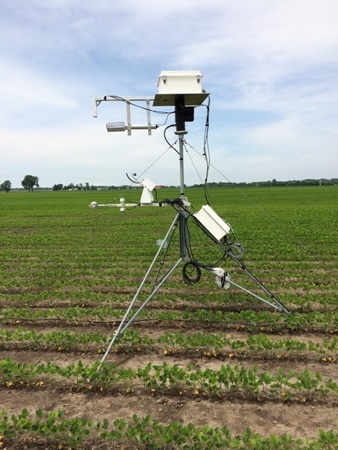May 16 2016
The term climate change is often associated with greenhouse gases like carbon dioxide, but researchers want to discover what influence materials on the ground have.
 The EcoSpecreflectance sensors in position among young soybean plants at the beginning of the 2015 growing season. Image courtesy of Yuki Hamada
The EcoSpecreflectance sensors in position among young soybean plants at the beginning of the 2015 growing season. Image courtesy of Yuki Hamada
The reality of climate change on the surface of Earth was studied by Yuki Hamada, a biophysical remote sensing scientist in the Environmental Science division at the U.S. Department of Energy's (DOE's) Argonne National Laboratory. She studied the interaction between the atmosphere near the ground and the plants and soil, instead of dwelling far into the troposphere. She hopes that the soybean plants that she has researched would shed light onto how the climate is changing, how the Earth’s ecosystems are affected by such changes, and how the function of ecosystem could feed back onto the climatic patterns.
With climate, we tend to talk all about the atmosphere, but actually the atmosphere, land and ocean are all connected. We're going to have to have a comprehensive understanding of how each piece interacts with each other — this is very important for more reliable forecasts of future climate change.
Yuki Hamada, Biophysical Remote Sensing Scientist, Argonne National Laboratory
The EcoSpec project was launched at Argonne in 2014 by Hanada and her research team in an attempt to achieve this goal. Their main aim was to create and assess devices and methodologies that could take the pulse of the flora and soil without sampling the materials.
Currently, we have very sophisticated capabilities for measuring the atmosphere, but we have very poor measurement capabilities for land surfaces. In EcoSpec, we rely on so-called passive remote sensing, which uses the energy source of the sun, and we are measuring the photons or energy reflected by plants and soils.
Yuki Hamada, Biophysical Remote Sensing Scientist, Argonne National Laboratory
Hamada used a "hyperspectral" reflectance sensor mounted on 10-foot towers which could measure the sunlight which was reflected by soil and plants from blue to shortwave infrared wavelengths to measure the solar energy reflecting from the soybean fields, which were located within the Fermi National Laboratory property at about 30 miles from Argonne.
The researchers hope to correlate the spectral data with the aspects of plant chemistry and physiology like carbon flux, nitrogen content, and moisture which are being studied by other researchers, and thus understand the overall plant health and activities.
We are hoping to discover the set of wavelengths and determine statistical patterns that can indicate ecosystem function — specifically photosynthesis and plant respiration, which directly relate to the carbon cycle and water cycles. Then an ecologist can take those measurements to build models of how plants grow and how they respond to climate changes.
Yuki Hamada, Biophysical Remote Sensing Scientist, Argonne National Laboratory
Since the atmosphere and the biosphere are connected in a feedback loop, improving these models will help to predict how the ecosystem would respond to the climate change and how the atmospheric shifts are caused by plant life.
"Flux towers" that stand next to the EcoSpec tower are being managed by other Argonne researchers at Fermilab to measure various factors like carbon dioxide flux, precipitation, temperature, etc. which Hamada requires for her correlation studies.
According to John Gamon, plant ecophysiologist from the University of Alberta, even though the EcoSpec project is based on the soybean fields, the protocols and instruments that would be developed could be applied to all other ecosystems as well.
10 years ago, a non-profit data-sharing effort called SpecNet (Spectral Network) was launched by Gamon. SpecNet seeks to link researchers across the globe like Hamada who are collecting the spectral data. Gamon hopes that Hamada’s work on the hyperspectral sensor would significantly contribute to the dataset under SpecNet as well as the tools other investigators within the network would be able to use.
With EcoSpec we get a deeper understanding of the underlying processes. And then having that as part of a network, we can say, 'Well, do these things hold across all ecosystems? Is there a universal truth here? Or is it just unique to crops or to certain kinds of ecosystems?'
John Gamon, Plant Ecophysiologist, University of Alberta
Hamada's sensor system, built and designed by herself and her associates at Argonne, has been recording the data from the Fermi soybean plots since last spring and has collected measurements till October.
As the volume of data from the sensors is increasing, Hamada has planned to team up with the Mathematics and Computer Science division and Argonne Leadership Computing Facility to analyze the data, using Argonne's computing systems.
It's going to need computation and big-data analytics.
Yuki Hamada, Biophysical Remote Sensing Scientist, Argonne National Laboratory
Hamada has recently started exploring her work with a collaborator at the computing facility to help discover unknown or difficult associations between environmental measurements and spectral reflectance data by developing visualization techniques. "We are hoping insights gained from new visualization of hyper-dimensional data will help us formulate interesting hypotheses," she said.
The insights they're able to glean could reach into unknown aspects of the interaction between the biosphere and the atmosphere. With higher resolution understanding of the processes that are happening at that plant and the light around it, you're going to probably come up with things you haven't seen before.
Nicki Hickmon, Meteorologist, Argonne National Laboratory
These measurements may be included into large-scale climate models that are used for making informed policy decisions at the global level.
Our findings will provide the fundamental understanding that can be used for satellite measurements. We would love to be able to provide some insights to that effort as well.
Yuki Hamada, Biophysical Remote Sensing Scientist, Argonne National Laboratory
This work is supported through Argonne's Laboratory Directed Research and Development program. The Argonne Leadership Computing Facility is a DOE Office of Science User Facility.